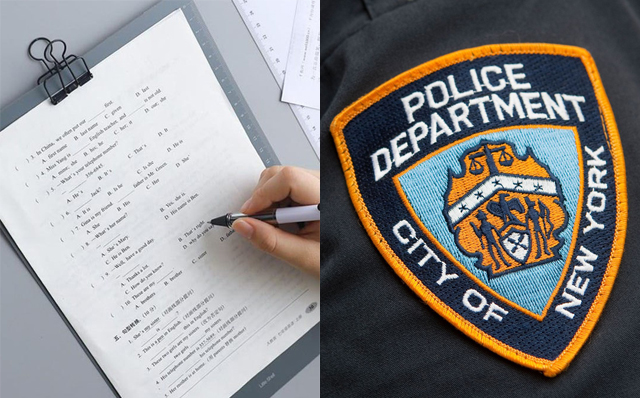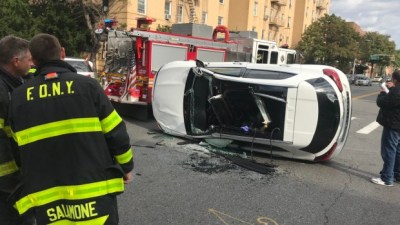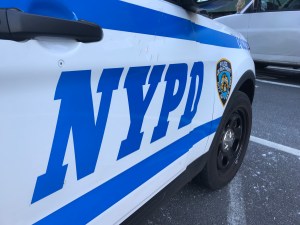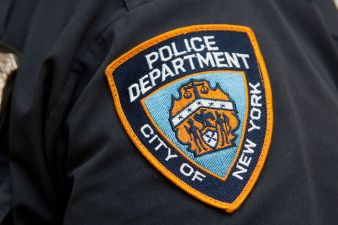TODAY AT CITY HALL: NYPD Will Push Back on Council Effort to Give DOT Crash Investigation Power

Whose vision should lead Vision Zero?
The NYPD and all five District Attorneys oppose a City Council bill to move the Collision Investigation Squad into the Department of Transportation — with law enforcement pushing a narrative at a hearing on Wednesday that the bill would decriminalize reckless driving, sources said — but a platoon of advocates, experts and the bill’s sponsor will push back, arguing that the agency that oversees the mayor’s Vision Zero initiative must also lead the investigation when it comes up short.
“It’s about basic accountability,” said Council Member Ydanis Rodriguez, the sponsor of the bill that will get its first hearing at 10 a.m. on Wednesday. “The responsibility to lead Vision Zero was given to the DOT commissioner. That person is responsibility to make the street safe for everyone, so that person needs to be coordinating everything.”
That may sound logical on the face, but the NYPD is expected to testify on Wednesday that only its detectives should oversee crash investigations because some crashes — it is actually a tiny percentage of the 250,000 or more crashes every year in New York City — result in a determination that the driver committed a criminal act. The agency is expected to cite several high-profile crashes that led to charges, such as last week’s arrest of a bus driver who killed a 4-year-old yeshiva student in Bensonhurst. (And the DOT is expected to agree with the police. The NYPD declined several interview requests over several days for this story.)
But that narrow world view clashes with the reality of New York’s unsafe roadways, experts say. For one thing, the current 25-person Collision Investigation Squad only responds to roughly 5 percent of the estimated 4,000 serious and fatal crashes, as Streetsblog has reported. When the Council sought in 2019 to double the size of the CIS to help it investigate more crashes, the NYPD declined.
The bill would not only make the DOT the lead agency on crash investigations, but it would also expand CIS staffing and require it to investigate, analyze and report on “all serious vehicular crashes” — wording that could require thousands more investigations.
The phrase “report on” is also crucial to the bill because currently, the NYPD’s CIS reports are not made public, and their findings, such as whether a crash occurred because of some particular road design element that is unsafe, are not routinely passed along to the DOT. The bill would require not just the standard review of the potential criminality of the driver who killed or maimed, but also mandate that the DOT “review the existing street design and infrastructure at the location of each serious vehicular crash, and any available crash data or reports on locations with similar street design or infrastructure citywide.”
In other words, the analysis of a crash on, say, West End Avenue in Manhattan would require DOT to review the design of every street like West End Avenue — which includes scores of similar roadways citywide.
And the DOT-overseen CIS would then be required to “make recommendations, if any, for safety maximizing changes to street design or infrastructure at the location of such crash, or citywide” and “determine whether changes to street design or improvements to infrastructure could reduce the risk of subsequent serious vehicular crashes.”
That’s not just a game-changer — that’s a massive culture shift, said Marco Conner DiAquoi, the deputy director of Transportation Alternatives, which has been calling for CIS reform for years.
“This would be a critical change in the culture of how we look at crashes,” he said. “In general, the CIS simply fails to look at the root cause of crashes.”
Over the summer, TransAlt issued a report [PDF] that called for reforming the Collision Investigation Squad, but stopped short of fully divesting it from the NYPD. The report, issued in the context of the NYPD’s radicalized police tactics, rings true at any time, however:
- The NYPD does not do enough to battle criminal driving as it is. In 2017, for example, there were 46,000 hit-and-run crashes in New York City, yet police arrested just one percent of those drivers.
- The report cited many examples of what does help reduce crashes: better road designs, protected bike lanes, and other DOT interventions.
- By refusing more funding to expand the mission of the CIS, the NYPD is admitting that it is not committed to fully investigating even a small percentage of serious crashes.
No more blaming the victim?
Supporters of the bill also believe it will address one of the biggest concerns about the NYPD — a victim-blaming, driver-absolving worldview that many believe comes from the fact that most NYPD officers live in the suburbs; drive to work and on the job; and see crashes as just “accidents” when, in fact, they are almost always the result of driver error, willful negligence or poor road engineering that allows for recklessness.
“Right now, the NYPD is entirely focused on individual culpability — what the driver did or whether the cyclist was wearing a helmet,” Conner DiAquoi said.
And, of course, if a crash requires a criminal investigation, the NYPD would obviously still be involved, under the bill, which states, “In conducting the [crash] review, the [DOT] unit may coordinate with the Police Department, Department of Health and Mental Hygiene, Office of the Chief Medical Examiner, or any other agency, office or organization as determined by the department.”
“We’ve never called for DOT to be the evidence-gathering entity at a crash site,” Conner DiAquoi said.
The bill would require DOT to take over the job of informing the media and the public about the details of a crash, which supporters said would reduce instances when the police department’s preliminary narrative is released prematurely.
“The NYPD routinely engages in victim-blaming, and its communications with media and premature statements about culpability tend to cast the victim in a terrible light,” said Conner DiAquoi. “Any member of Families for Safe Streets will tell you that their interactions with the police are uniformly negative.”
There is seemingly — tragically — an endless supply of crash victims or victims’ families who have criticized the police for poor investigations that did not focus on the needs of the victims:
- Dulcie Canton effectively solved the hit-and-run crash that left her near dead in 2014.
- The parents of Jack Koval, who was killed in 2016, had to conduct their own investigation because police initially blamed their son for his death.
- In 2016, the NYPD blamed a cyclist for biking the wrong way on Classon Avenue in Brooklyn, only to later admit that she had not done that.
- In 2017, The NY Times reported, the family of Tishira Japa had to conduct its own investigation, also after the NYPD blamed the victim and conducted a slapdash review of the crash.
- A mother whose son was killed by a bus driver who allegedly ran a red light in 2018 said the NYPD “traumatized” her by blaming the 7-year-old for his own death.
- In 2019, cops initially blamed cyclist Abul Bashar for his death under the wheels of a garbage truck, only to secretly amend the CIS report months later.
- Last year, a CIS report on the death of Mario Valenzuela in Queens was filled with mistakes that exonerated a truck driver for running over the teen.
- In 2016, pedestrian Bernadette Karna survived a hit and run only to learn that the CIS did not bother to investigate at all. That failure led to evidence being destroyed, completely undermining her ability to get justice
On Tuesday in Streetsblog, Karna called for the DOT to take over crash investigations, citing her experience and “the utter failure of the NYPD to investigate my crash,” she wrote.
“Whether it is a lack of resources to investigate and prosecute drivers or an apathy that these are just ‘accidents’ is unclear,” Karna added. “But what is obvious is that the justice system doesn’t bring justice to crash victims or hold reckless drivers accountable. … It is not acceptable that the driver can simply deny responsibility, and refuse to cooperate with police, without any consequences.”
“Removing victim-blaming and putting the DOT in charge of public information as well as analyzing design flaws that led to the crash,” DiAquoi added, “would lead to mainstream media coverage that is not simply focused on the drivers themselves, but on the critical issues like road design and roads that are built to allow speeding.”
What are ‘best practices’?
Here’s one thing going against the would-be reformers: It does not appear that any U.S. city puts the transportation agency at the forefront of crash investigation. The City of Berkeley voted last year to create a new transportation department which supporters believe will indeed investigate crashes, but the change has not gone into effect yet as the thorny details get worked out.
Meanwhile, the City of Seattle, which is widely praised for its post-crash engineering, still has the local police department lead its crash investigations. But a city engineer is required to visit a crash site very soon after all fatal crashes to report on possible road fixes — more lighting, more signage, etc — that could prevent future crashes.
“Evidence-gathering, life-saving, prosecution — those are police matters and we are hands-off,” the city’s Traffic Engineer Dongho Chang told Streetsblog. “But as soon as they’re done, we get to that scene and document the conditions so we can know what happened and then address the issues.”
Chang said that crash investigation is far more important than mere criminal prosecutions — and that cops are ultimately only up to part of the challenge.
“The goal of crash investigation is to get to the point of not having crashes at all,” he said. “So that’s why we [Seattle DOT] investigate and make changes going forward.”
He cited two recent examples of how a post crash investigation — begun by police but ultimately concluded by the DOT — led to significant changes in the streetscape. One, a cyclist death on E. Marginal Way in 2013, led to improvements that got under way within two weeks. Another crash in September, 2019, killed a senior citizen — and also within two weeks, the city committed to roadway improvements.
Currently in New York City, police investigations do not yield information that is transferred to the Department of Transportation, rending crash sites useless regarding the specifics of crashes. In London, which also has a reputation for doing investigations correctly, the police do indeed investigate crashes, but the transportation agency, Transport for London, oversees the cops.
“TFL pays for road policing and so we work in very close partnership [with the police],” said Will Norman, who is London’s famed Walking and Cycling Commissioner. “We set the policy agenda, but the police have the legal power. It works well.”
To Charles Komanoff, a former Transportation Alternatives head and transportation expert, the failure of the NYPD to conduct investigations that lead to street safety changes is the biggest problem with police oversight of crash analysis.
“The NYPD Highway Division produces no annual digest aggregating and distilling the individual analyses. Is driver speeding the number one scourge of pedestrians and cyclists? Or is it red-light running? Perhaps driver distraction? What about aggressive driving?” Komanoff wrote in Streetsblog last year. “CIS reports could tell us the relative frequencies, informing public policy and enriching civic discourse about traffic violence. If the NYPD didn’t bury them.”
He called for a new unit led by staff from the departments of Transportation and Health and aided by the medical examiner’s office — people, he said, who are “versed in science and trained to check their biases at the door.”
Meanwhile, earlier this year, Council Member Brad Lander, who is a co-sponsor of the Council bill, called for putting CIS entirely under DOT purview [PDF] “to become a powerful enhancer of road safety.”
With DOT running the investigations, Lander argued, “CIS would expand its focus not only on determining criminality for individual crashes, but also on broadly assessing factors underlying traffic risk and safety in order to make strategic recommendations for preventing future traffic violence,” he wrote, arguing that CIS needs to be expanded so that it can assess “thousands of serious but non-fatal crashes.”
Mayor de Blasio opposes the Council bill, telling Streetsblog last week that crash investigation has “multiple purposes” — one of which is a police matter.
“There’s the criminal justice element of this: I want to see stronger penalties for people who hurt or kill other people with their automobile,” he said. “I still think we have farther to go on that front. … I want to see more stringent investigations that lead to consequences.”
But he also said he wanted to see “that crash investigations lead to structural change — design changes or what else is needed.”
“We have to get everyone working together,” he said.
Rodriguez, the bill sponsor, agrees, but definitely wants the NYPD to play the subservient role.
“The NYPD is not investigating many crashes to begin with, so this bill is about getting someone who is responsible — the person we designate to handle Vision Zero — to coordinate the full response,” he said. “Having the Collision Investigation Squad under DOT is about coordination.”




